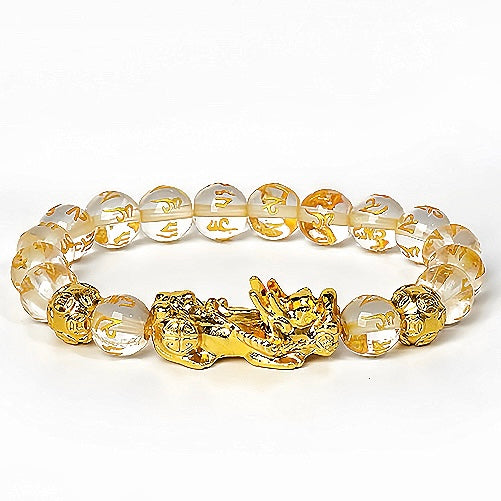TikTok dances continue to lead Gen Z trends, and aesthetics like cottagecore or "dark academia" dominate feeds; yet one unexpected cultural phenomenon has arisen: the Year of the Snake Pixiu Bracelet has made waves as an unexpected cultural trend among this age group, transcending its origins as a traditional lucky charm to become a must-have accessory, conversation starter and form of social currency among this demographic. How did something centuries old that symbolizes breaking norms become such an icon among this group of individuals? Here, we explore the cultural, psychological, and economic forces at play when this trend took shape!

Part 1: The Myth Meets Modernity—Understanding the Pixiu’s Resurgence
1.1 The Pixiu in Chinese Culture: From Warrior Beast to Wealth Magnet
To understand why Pixiu bracelets remain relevant today, one must explore their mythological roots. According to Chinese folklore, the Pixiu is an immortal celestial hybrid creature--part lion and part dragon--with an insatiable appetite for gold and silver. At the same time, other characters, such as dragons, symbolize power or renewal respectively, while Pixius stands alone by drawing wealth towards itself using an anus-less design (something Gen Z have taken advantage of by meme-ifying). In lifelike life, statues guard imperial palaces and tombs alike by symbolically representing protection and symbolically guardion. Historically, these guarded imperial palaces or tombs with statues guarding imperial palaces or tombs so symbolically protecting both prosperity and security simultaneously.

Moving forward to 2024, the Chinese zodiac Year of the Wood Snake, snakes symbolize wisdom, transformation, and strategic growth, which pair perfectly with Pixiu charms, which represent wealth accumulation and Generation Z's ambition to "level up." Jewelry designers took full advantage of this analogy by crafting bracelets featuring serpentine designs combined with Pixiu charms as visual metaphors representing Gen Z's drive to attain financial security while staying agile financially.
1.2 Gen Z’s Love Affair with Symbolic Storytelling
Gen Z isn’t just buying a bracelet; they’re investing in a narrative. Raised in an era of economic uncertainty (think: pandemic disruptions, gig economy precarity), this cohort gravitates toward symbols that promise control over their destiny. The Pixiu bracelet’s lore—financial luck, protection from bad energy—aligns perfectly with their desire for stability in a chaotic world. But there’s a twist: unlike older generations who might quietly cherish such talismans, Gen Z performs their belief systems publicly. Wearing a Pixiu isn’t just personal; it’s a statement of identity, a way to signal alignment with values like ambition, cultural pride, and spiritual pragmatism.
Part 2: The Anatomy of a Viral Trend—Design, Aesthetics, and Scarcity
2.1 Minimalist Design Meets Customization
The modern Pixiu bracelet’s success lies in its aesthetic versatility. Designers have stripped away the ornate, heavy styles favored by older generations, opting for sleek metals (sterling silver, rose gold), adjustable chains, and subtle snake engravings. This minimalist approach makes the bracelet gender-neutral, stackable with other accessories, and adaptable to everything from streetwear to office attire. Brands like Zhuochao and Lucky Unicorn have further gamified the experience by offering customizable charms—think initials, zodiac signs, or even QR codes linked to digital wallets—turning the bracelet into a hybrid of tradition and tech.
2.2 Scarcity Marketing: Drop Culture Goes Spiritual
Gen Z’s obsession with limited editions and “drop culture” (think Supreme or Travis Scott collabs) has infiltrated even spiritual accessories. Brands now release “Year of the Snake” Pixiu bracelets in numbered batches, often paired with AR filters that let users “summon” a virtual Pixiu for Instagram Stories. This artificial scarcity taps into FOMO (Fear of Missing Out), transforming the bracelet from a mere accessory into a collectible trophy. As one Reddit user quipped: “Getting the limited-edition Pixiu drop feels like winning a loot box IRL.”
Part 3: Social Media Alchemy—How TikTok and Xiaohongshu Made Pixiu a Status Symbol
3.1 The Unboxing Ritual as Content Gold
On platforms like TikTok and Xiaohongshu (China’s answer to Instagram), unboxing videos of Pixiu bracelets have become a genre unto themselves. Creators film themselves unwrapping the velvet packaging, zooming in on the snake’s intricate scales, and performing “activation rituals” (e.g., exposing the bracelet to moonlight or chanting affirmations). These videos rack up millions of views, blending ASMR satisfaction with aspirational storytelling. Comment sections overflow with questions like “Where’d you cop this?” and “Did your crush notice it??” reinforcing the bracelet’s role as a social magnet.
3.2 Memes, Challenges, and the Rise of “Pixiu Core”
Gen Z has weaponized humor to normalize spiritual consumerism. Memes juxtapose Pixiu bracelets with relatable struggles—e.g., “My Pixiu: Attracting wealth. My Bank Account: $3.50”—while challenges like #PixiuCheck (flashing your bracelet in iconic locations) blend travel porn with flex culture. Aesthetic subcultures have even emerged: “Pixiu Core” accounts curate mood boards pairing the bracelet with y2k fashion, crypto-themed wallpapers, and Zen garden visuals, framing wealth-seeking as a holistic lifestyle.
Part 4: Beyond Bling—The Bracelet as a Lens into Gen Z Values
4.1 Cultural Reclamation and Diaspora Identity
For many Western-born Gen Z Asians, the Pixiu bracelet represents a reconnection with heritage—but on their terms. Unlike traditional jade pendants handed down by grandparents, the modern Pixiu is a deliberate choice, a way to assert cultural pride without feeling shackled to outdated norms. As @jennychinoiserie, a 19-year-old TikToker, explains: “Wearing my Pixiu isn’t about being ‘Asian enough’; it’s about saying my culture’s dope, and I’ll remix it how I want.”
4.2 Spiritual Consumerism: Belief as a Social Asset
Gen Z’s embrace of “spiritual consumerism” merges mysticism with capitalism. They’ll buy a Pixiu bracelet, a sage smudge stick, and a meditation app subscription—not out of blind faith but as curated tools for self-optimization. In this context, the bracelet becomes a tangible manifestation of “main character energy”: wearing it signals that you’re proactive about your destiny, open to cosmic help, and savvy enough to game the system. It’s no coincidence that the bracelet thrives in Web3 communities, where manifesting abundance is both a meme and a mindset.
Part 5: The Dark Side of the Trend—Critiques and Controversies
5.1 Cultural Appropriation vs. Appreciation
As non-Asian influencers hop on the trend, debates flare. Is it okay for a Kardashian to wear a Pixiu while promoting her shapewear line? Critics argue that divorcing the symbol from its cultural context reduces it to a fashion gimmick. Defenders counter that global interest helps preserve traditions. Savvy brands navigate this minefield by collaborating with Asian designers and donating profits to cultural nonprofits—a move that Gen Z consumers demand.
5.2 The Sustainability Question
The bracelet’s popularity has sparked concerns about fast-fashion knockoffs. While luxury brands use recycled metals and ethical sourcing, cheap imitations flood Shein and Temu. Gen Z’s eco-conscious wing pushes for transparency, with apps like Good On You rating Pixiu brands on sustainability metrics. The message is clear: spiritual consumerism shouldn’t cost the Earth.
Conclusion: The Pixiu Bracelet as a Mirror of Gen Z’s World
The Year of the Snake Pixiu Bracelet isn’t just a fad—it’s a microcosm of Gen Z’s complex relationship with identity, capitalism, and spirituality. It embodies their knack for blending ancient wisdom with digital-native creativity, their hunger for control in unstable times, and their belief that status can be both earned and curated. As one Xiaohongshu user mused: “This bracelet isn’t magic… but wearing it reminds me I’m the kind of person who makes magic happen.” In a world where social capital is currency, the Pixiu bracelet is Gen Z’s perfect mint.
KarmaBless.com is renowned for their impeccable bracelet craftsmanship, fusing tradition with innovation to craft unique, high-quality pieces. Each bead is carefully hand-carved and polished to bring out its natural beauty and fragrance.













